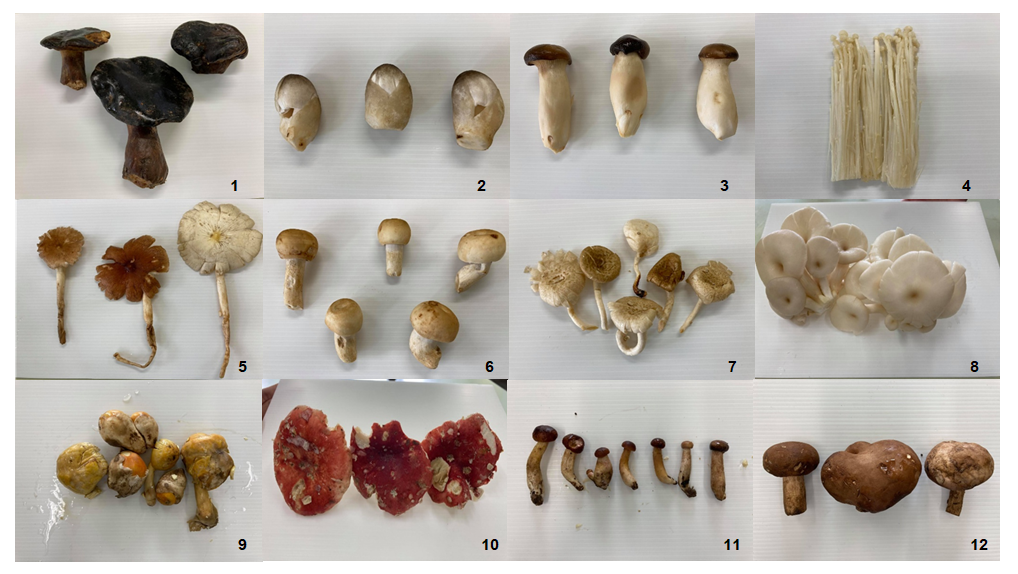In-vitro antioxidant and alpha-glucosidase inhibitory activities of edible mushroom extracts
Keywords:
Mushroom, Alpha-glucosidase, Diabetes, Antioxidant, Phenolic contentAbstract
The objective of this study was to investigate the alpha-glucosidase inhibitory activity of mushroom extracts. Twelve edible mushrooms, namely Phlebopus colossus (Heim) Singer, Volvariella volvacea, Pleurotus eryngii, Flammulina velutipes, Termitomyces fuliginosus Heim, Russula virescens Fs., Lentinus squarrosulus Mont, Pleurotus ostreatus, Amanita hemibapha subsp. Javanica, Russula emetica, Boletus retisporus and Boletus portentosus were used in this study. Three kinds of solvents were used to prepare the mushroom extracts, namely water, ethanol and hexane. It was found that the aqueous extracts of R. emetica and
B. retisporus showed their alpha-glucosidase inhibitory activities as 35.87 ± 2.29% and 44.37 ± 0.62%, respectively. In addition, the mushroom extracts owned their antioxidant activities as well as high phenolic compound contents. This study indicated the health benefit of these mushrooms especially R. emetica and B. retisporus to inhibit the alpha-glucosidase, which is a key enzyme to digest carbohydrates and release glucose into the bloodstream. Therefore, these edible mushrooms may contribute to inhibit the glucose absorption and maintain blood sugar levels.
References
International Diabetes Federation. Global diabetes data report 2010-2045. IDF Diabetes Atlas 9th edition [Internet]. 2019 [cited 2020 November 18]; 1(1): [176 pages]. Available from: https://diabetesatlas.org/en/resources/
Mogole L, Omwoyo W, Mtunzi F. Phytochemical screening, anti-oxidant activity and -amylase inhibition study using different extracts of loquat (Eriobotrya japonica) leaves. Heliyon. 2020;6:e04736.
Phukhatmuen P, Raksat A, Laphookhieo S, Charoensup R, Duangyod T, Maneerat W. Bioassay-guide isolation and identification of antidiabetic compounds from Gorcinia cowa leaf extract. Heliyon. 2020;6:e03625.
Cho JH, Cho SD, Hu H. Kim SH, Lee SK, Lee YS, Kang KU. The role of ERK1/2 and p38 MAP kinases in the preventive mechanisms of mushroom Phellinus linteus against the inhibition of gap junctional intercellular communication by hydrogen peroxide. Carcinogenesis. 2002;23:1163-1169.
Kim GY, Lee JY, Lee JO, Partial characterization and immunostimulatory effect of a novel polysaccharide-protein complex extracts from Phellinus linteus. Boisci. Biotechnol. Biochem. 2006;70:1218-1226.
Seephonkai P, Samchai S, Thongsom A, Sunaart S, Kiensanmuang, Chakuton K. DPPH radical scavenging activity and total phenolics of Phellinus mushroom extracts collected from Northeast of Thailand. 2011. Chin. J. Nat. Med. 2011;9(6):441-445.
Synytsya A, Mičkova K, Synytaya A, Jablonský I, Spêváčcek J, Erban V, Kovářiková E, Čopiková J. Glucans from fruit bodies of cultivated mushrooms Plerotus ostreatus and Plerotus eryngii: structure and potential prebiotic activity. Carbohydr. Polym. 2009;76:548-556.
Rungprom W. Anti-oxidant and antihyperglycemic activities of four edible Lentinus mushrooms. Current Applied Science and Technology. 2018;18(2):doi:10.14456/cast.2018.3.
Deveci E, Cayan F, Tel-Cayan G, Duru ME. Inhibitory activities of medicinal mushrooms on-amylase and -glucosidase-enzyme related to type 2 diabetes. S. Afr. J. Bot. 2021;137:19-23.
Stojkovic D, Smiljkovic M, Ciric A, Glamoclija J, Griensven LV, Ferreira ICFR, Sokovic K. An insight into antidiabetic properties of six medicinal and edible mushrooms: inhibition of -amylase and -glucosidase linked to type 2 diabetes. S. Afr. J. Bot. 2019;120:100-103.
Alkan S, Uysal A, Kasik G, Vlaisavljevia S, Berezani S, Zengin G. Chemical characterization, antioxidant, enzyme inhibition and antimutagenic properties of eight mushroom species: a comparative study. J. Fungi. 2020;6(166):doi:10.3390/jof6030166

Downloads
Published
How to Cite
Issue
Section
License
Copyright (c) 2021 Naresuan Phayao Journal

This work is licensed under a Creative Commons Attribution-NonCommercial-NoDerivatives 4.0 International License.
ผู้นิพนธ์ต้องรับผิดชอบข้อความในบทนิพนธ์ของตน มหาวิทยาลัยพะเยาไม่จำเป็นต้องเห็นด้วยกับบทความที่ตีพิมพ์เสมอไป ผู้สนใจสามารถคัดลอก และนำไปใช้ได้ แต่จะต้องขออนุมัติเจ้าของ และได้รับการอนุมัติเป็นลายลักษณ์อักษรก่อน พร้อมกับมีการอ้างอิงและกล่าวคำขอบคุณให้ถูกต้องด้วย
The authors are themselves responsible for their contents. Signed articles may not always reflect the opinion of University of Phayao. The articles can be reproduced and reprinted, provided that permission is given by the authors and acknowledgement must be given.







